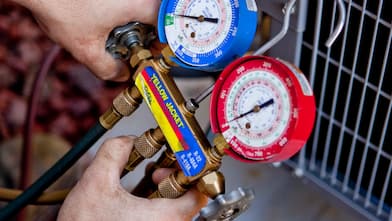Highlights
Furnace issues may result in a cold home and a spiking energy bill.
There are red flags indicating furnace problems, such as water leaks and a yellow pilot light.
If you encounter the following signs of furnace issues you can’t fix, hire an HVAC contractor.
When the cold winter months roll around, it can feel like the end of the world when your furnace is malfunctioning. There are several reasons why your furnace may not be working, and luckily, some of them are fixable homeowner issues. Learn about how to catch signs of furnace trouble so you can avoid expensive furnace repairs later.
1. Cold Air
It can be incredibly frustrating, particularly during the winter, to find that your home isn’t getting warm enough.
If you’re finding that the entire house is cold or certain spots are particularly cold, your furnace may not be properly functioning. This issue often has to do with the motor within the blower fan. The blower motor is what turns the blower fan and, in turn, circulates the air through the air ducts and into each room. When the blower fan malfunctions, the furnace won’t have enough power to heat the home sufficiently.
If you’re concerned your furnace isn’t functioning well, contact a local HVAC contractor who can check out your furnace and develop a solution before the problem gets worse.
2. Strange Noises
While a functioning HVAC system may make humming sounds, these are normal. On the flip side, if you notice pops, squeaks, rattling, or banging, you may be facing a furnace issue.
One potential issue is that the blower wheel isn’t functioning properly. The blower wheel helps bring in and out a certain air from the furnace system. If the blades are malfunctioning, they can trap debris and dirt, which can cause these noises.
Another possibility is loosened or worn-out mechanical parts inside the furnace. For instance, rattling noises may indicate a loose screw. If you notice strange noises coming from the furnace, hire a local HVAC company to determine the source and solution.
3. Increased Heat Bills
When your furnace isn’t working efficiently to heat the home, it uses more energy. Consequently, your heating bills can spike. This is particularly true for winter heating costs since your furnace may be working extra hard to warm your home.
The first thing to do is check the furnace filter. If the filter is dirty, it may be obstructing the furnace airflow and forcing it to work overtime. The filter is usually located in the blower compartment, which is in a box at the base of the furnace.
If it’s clogged, you’ll want to either clean it out or replace it. If you have a disposable filter, you’ll want to replace it every two to three months. If you have a permanent filter, you can clean it yourself by submerging it in a mixture of water and a small amount of laundry detergent.
Providing regular maintenance to your filter can also help extend its life. This includes filter changes, tune-ups, and inspections.
4. Furnace Doesn’t Start

If you’re having trouble turning on your furnace, don’t panic. As they age, furnaces can become more difficult to turn on. On average, they last around up to 20 years.
If your furnace is relatively new, you may need to reset the thermostat. Follow the steps below to reset your thermostat:
Turn the thermostat to its minimum setting.
Switch the furnace on and then off.
If you can successfully turn your furnace to the desired temperature, you’ve fixed the problem.
5. Water Leaks
Water leaks are a nuisance that many homeowners can relate to. While they aren’t dangerous, leaks can cause damage to flooring and walls and lead to mold growth.
Water leaks can occur when the furnace has a clogged condensation line connecting to the HVAC unit and funnels condensation outdoors. If a condensation line becomes clogged, you’ll likely see a pool of water surrounding the line.
Repairing the condensation line can be an extensive job, so your best bet is to hire an HVAC repair pro near you who’ll have the proper knowledge, experience, and tools to fix the issue. To prevent these problems in the future and ensure you catch them early on, you can make annual inspections with HVAC professionals.
6. Yellow Pilot Light
A furnace’s pilot light ignites the natural gas getting pumped into the main burner. This light should always be blue. A yellow pilot light indicates that the HVAC system may be failing, and you may need to call a pro for a furnace repair. This could mean a ventilation problem or that harmful gasses may be leaking.
Since there’s the possibility of your furnace leaking carbon monoxide—a poisonous gas—it’s essential to take action immediately. Carbon monoxide exposure can lead to carbon monoxide poisoning, which, if minor, will cause you to have symptoms such as headaches, dizziness, nausea, and fatigue. More major exposure can lead to disorientation, vomiting, and fainting.
If you notice a yellow pilot light, shut off your furnace and contact an HVAC technician near you.




